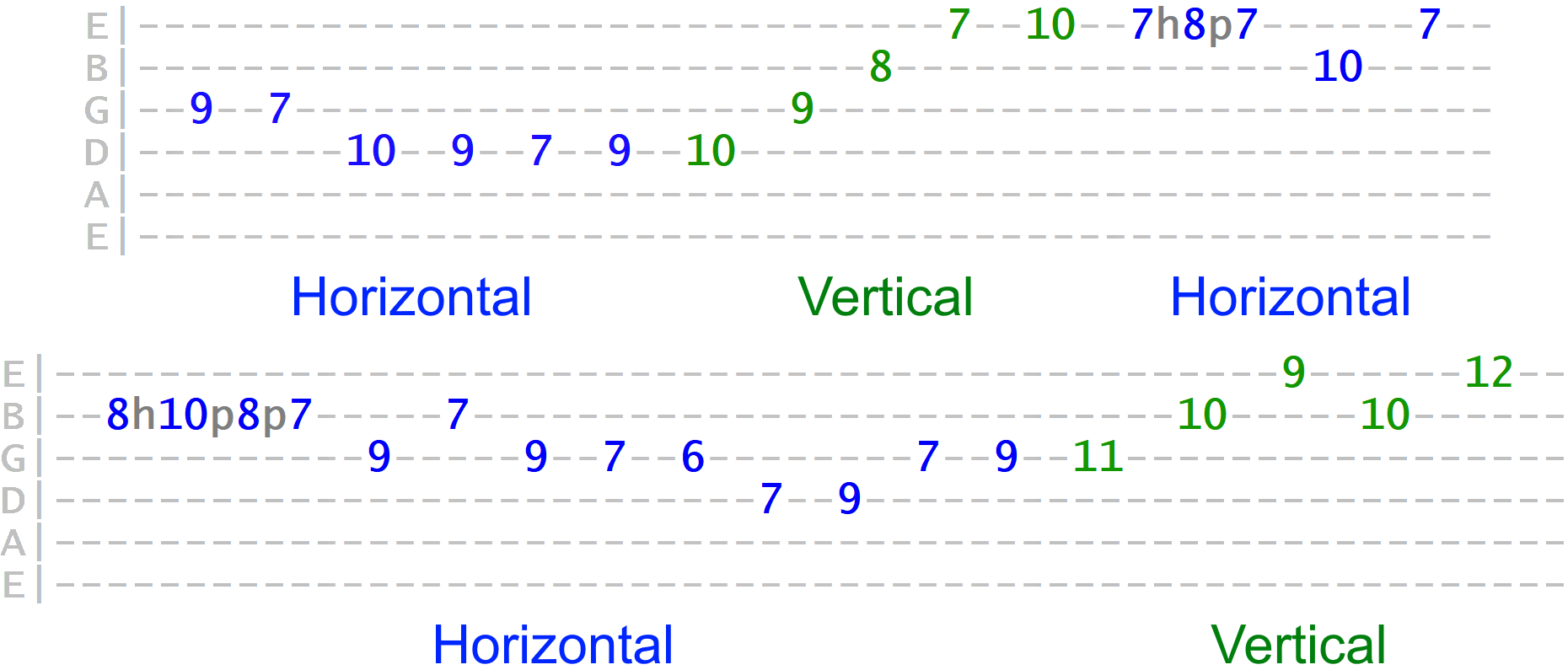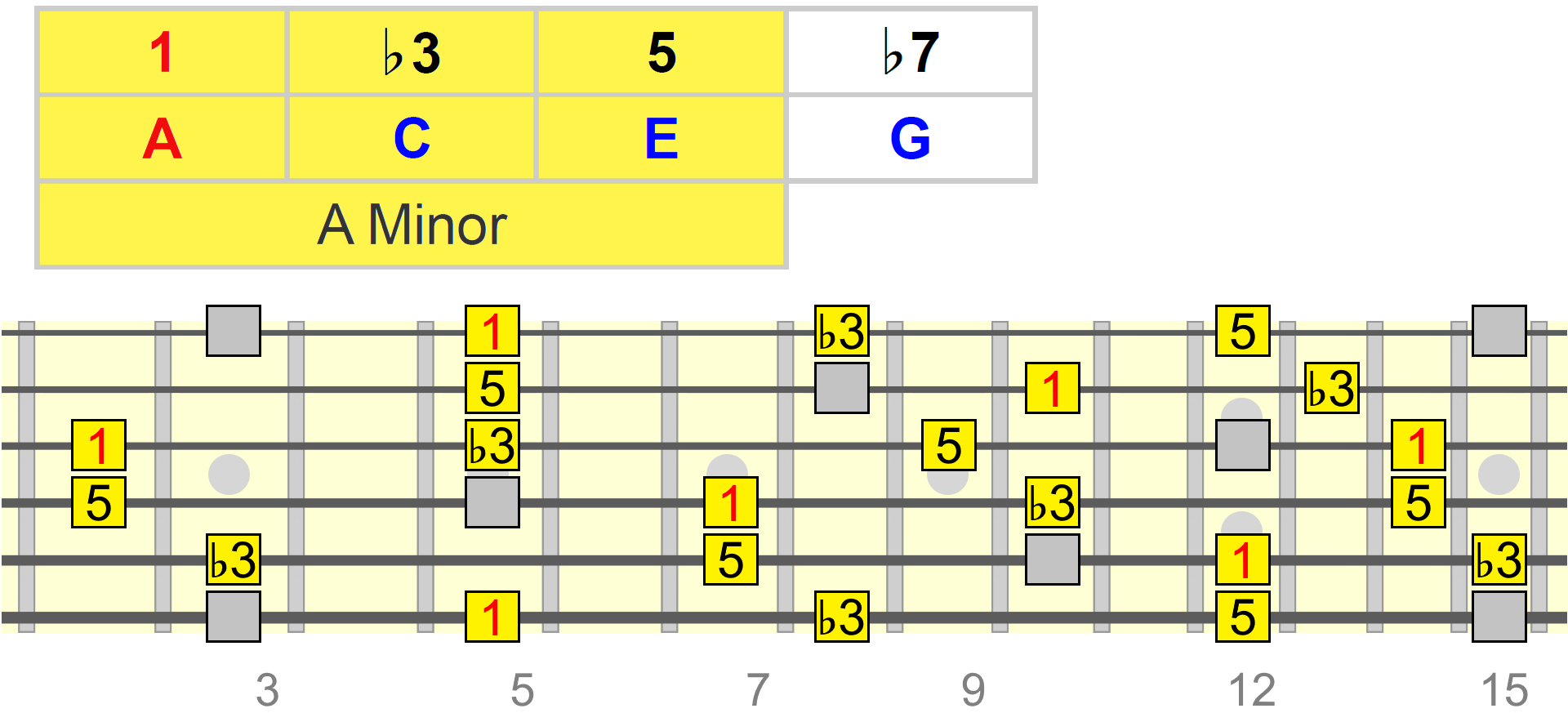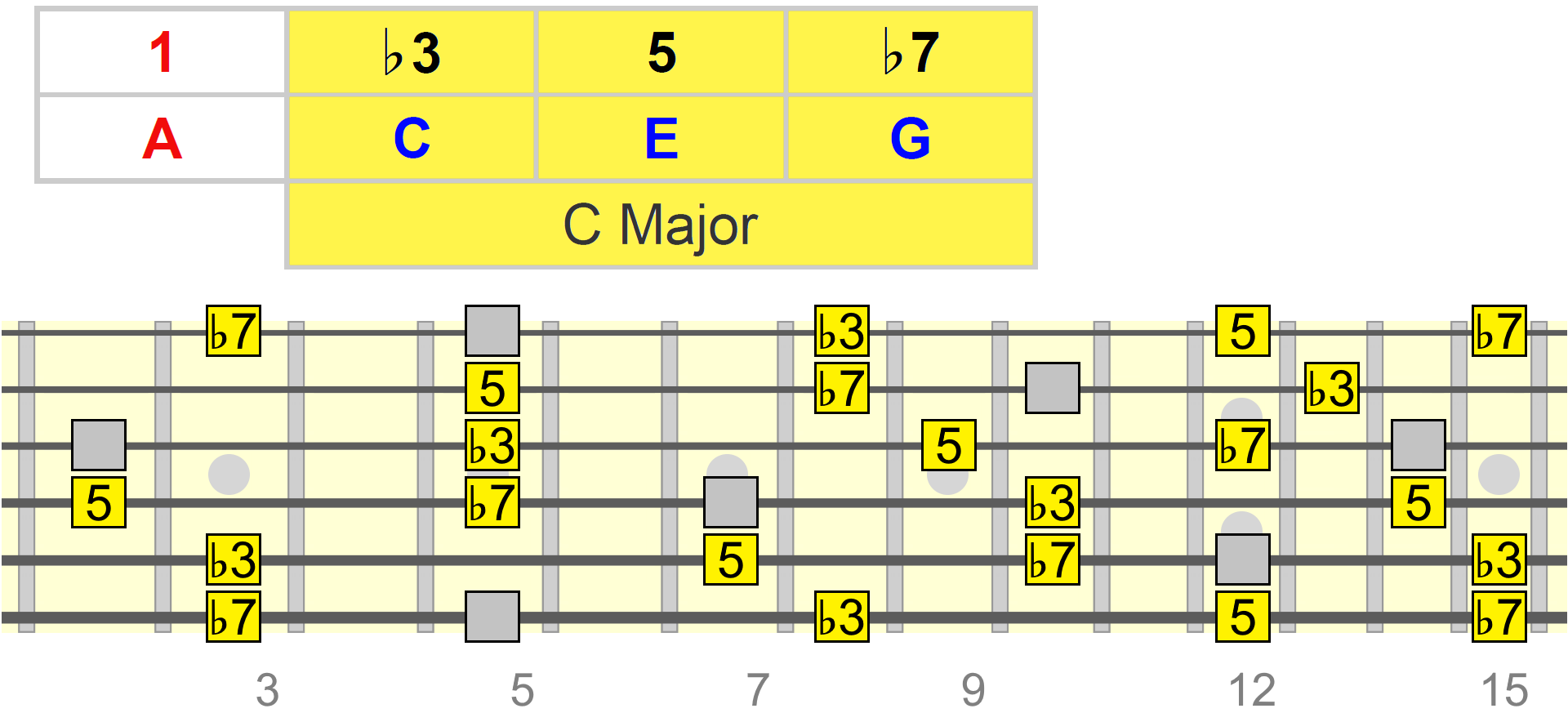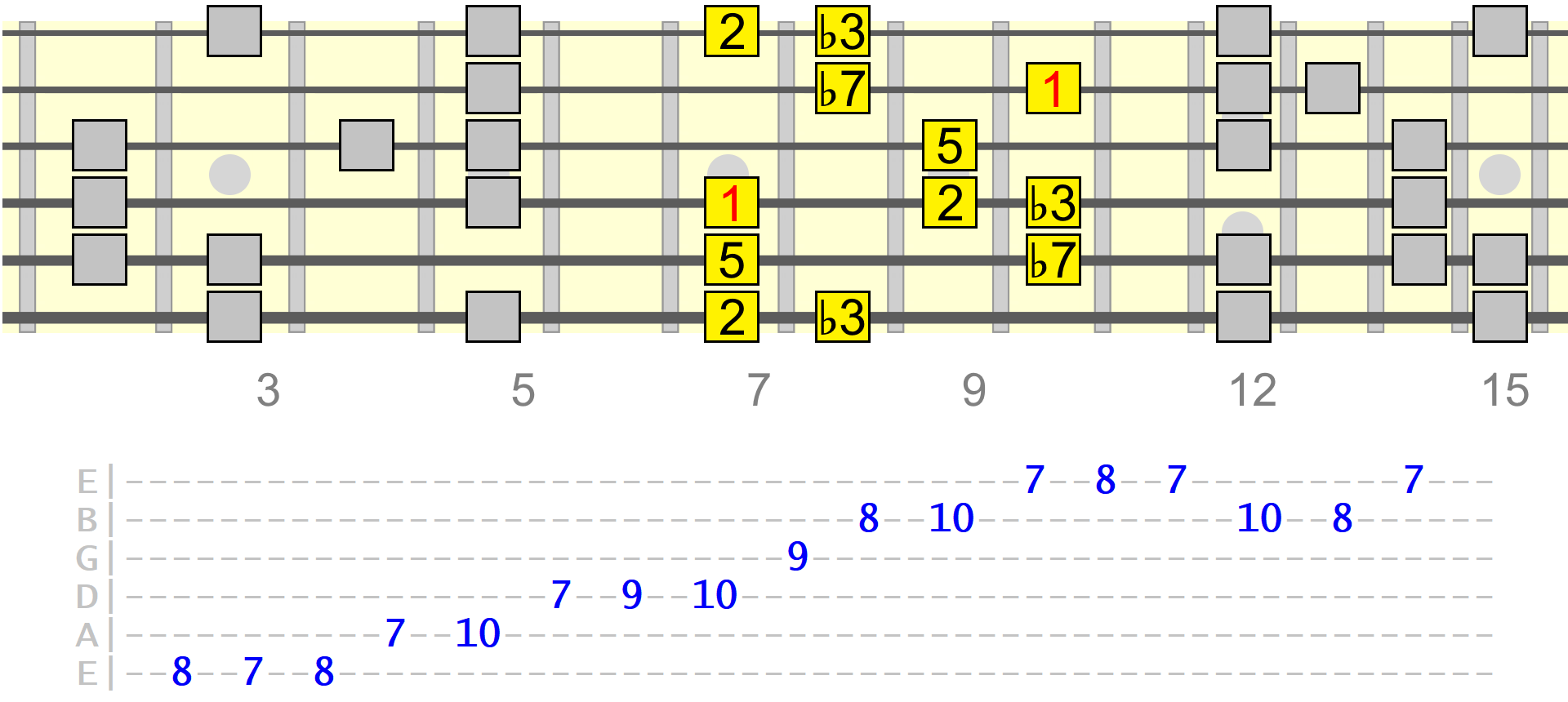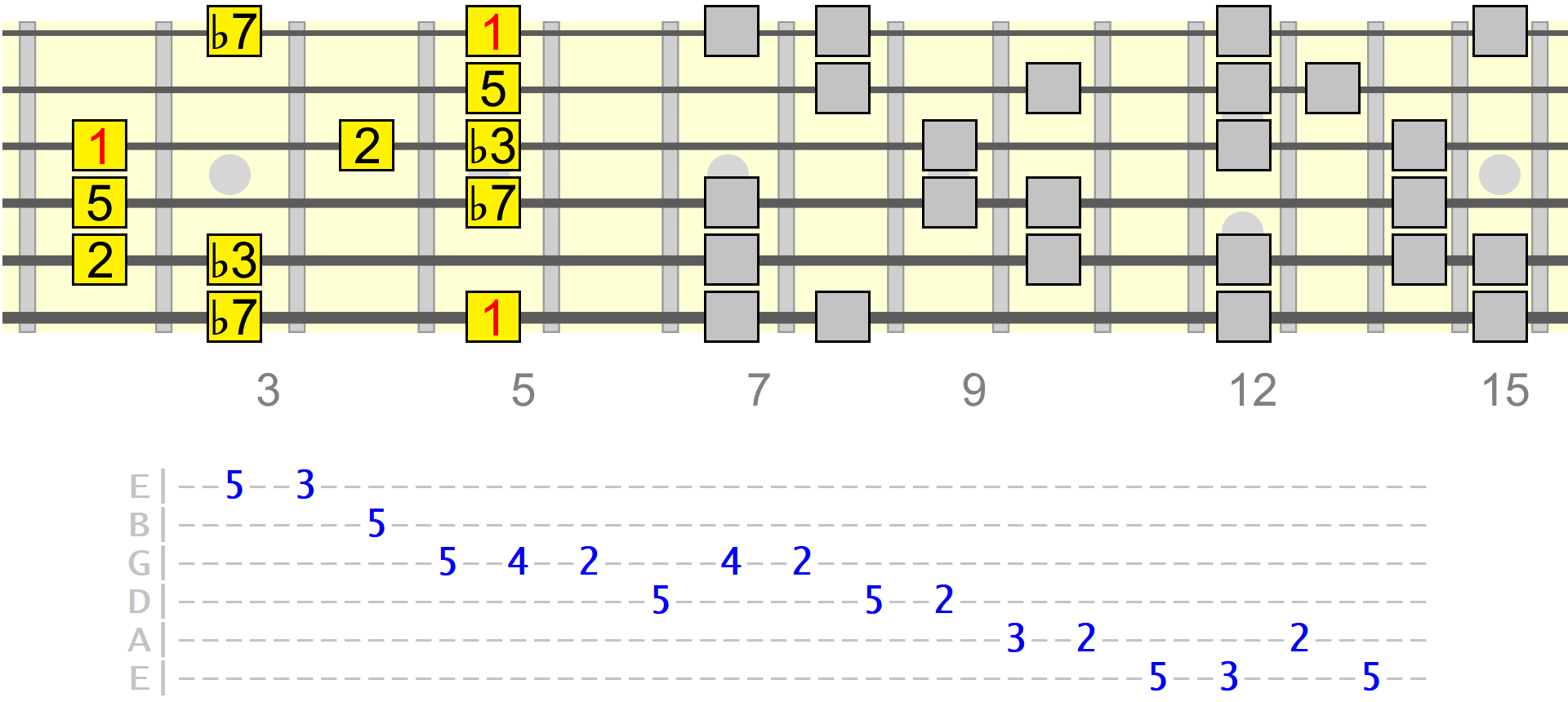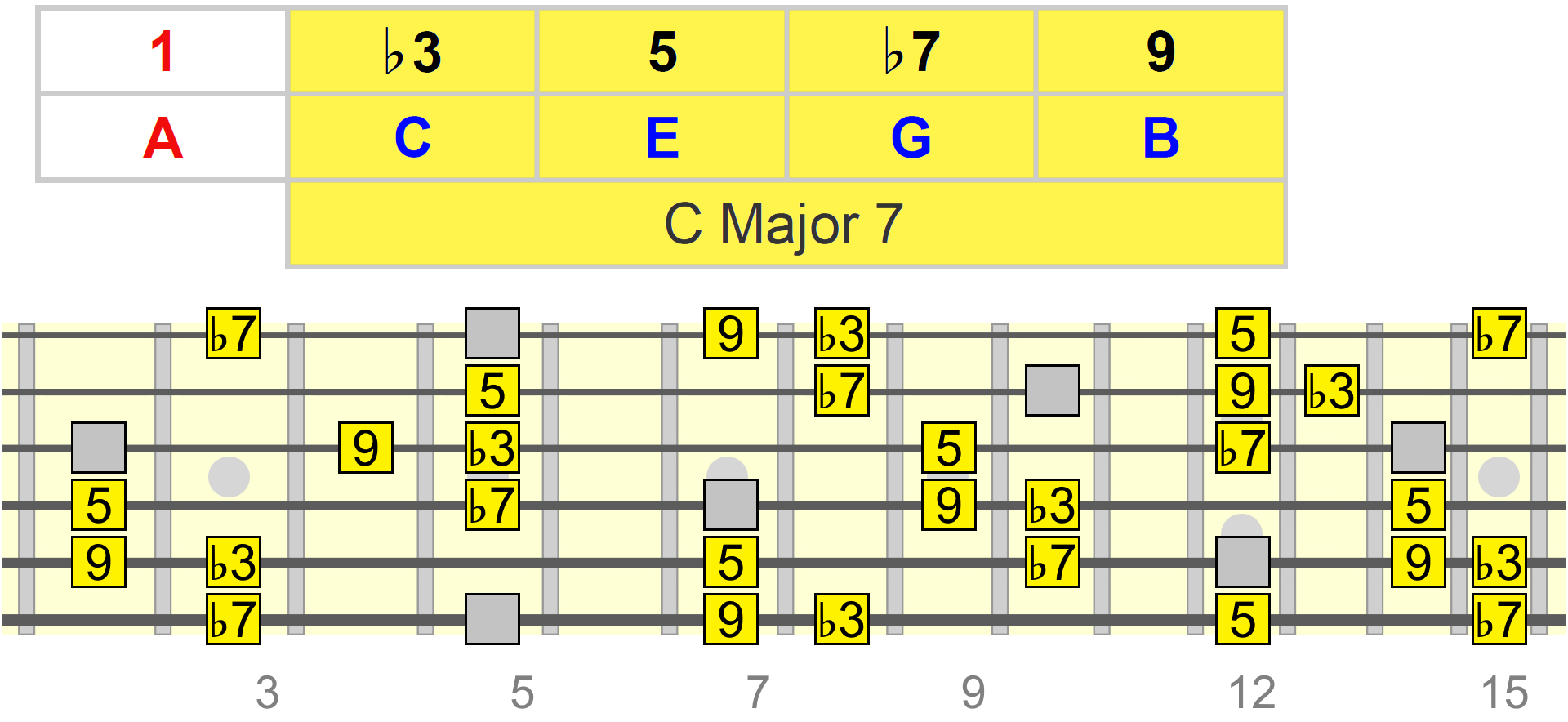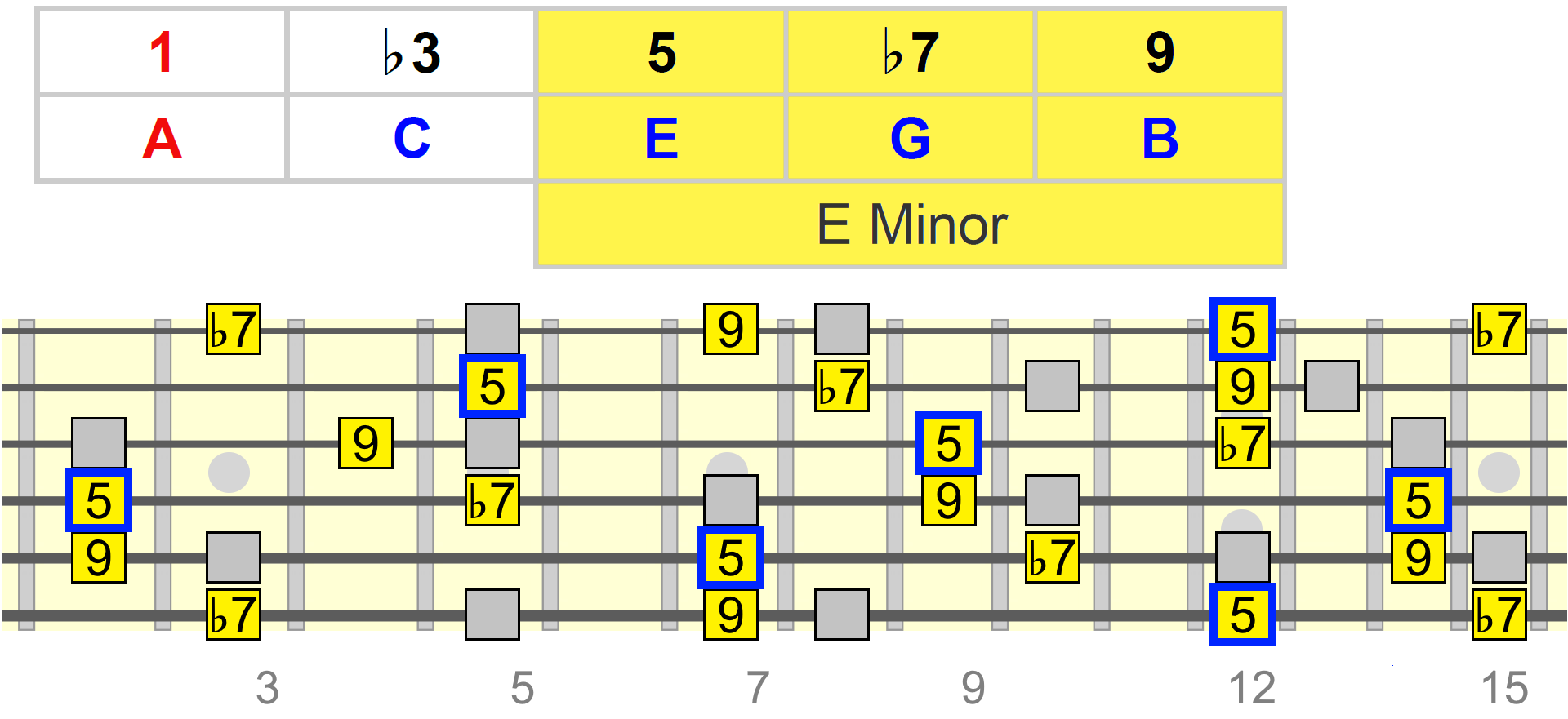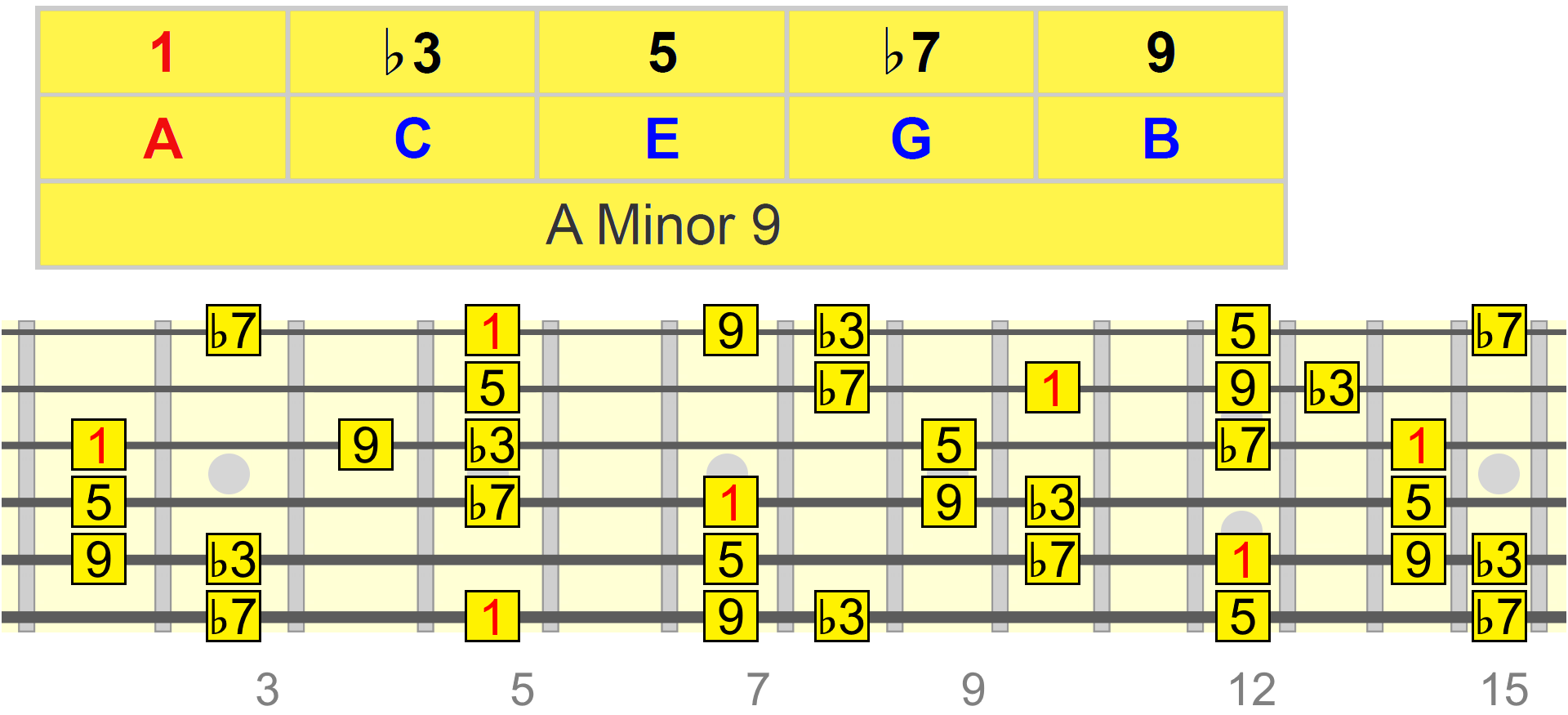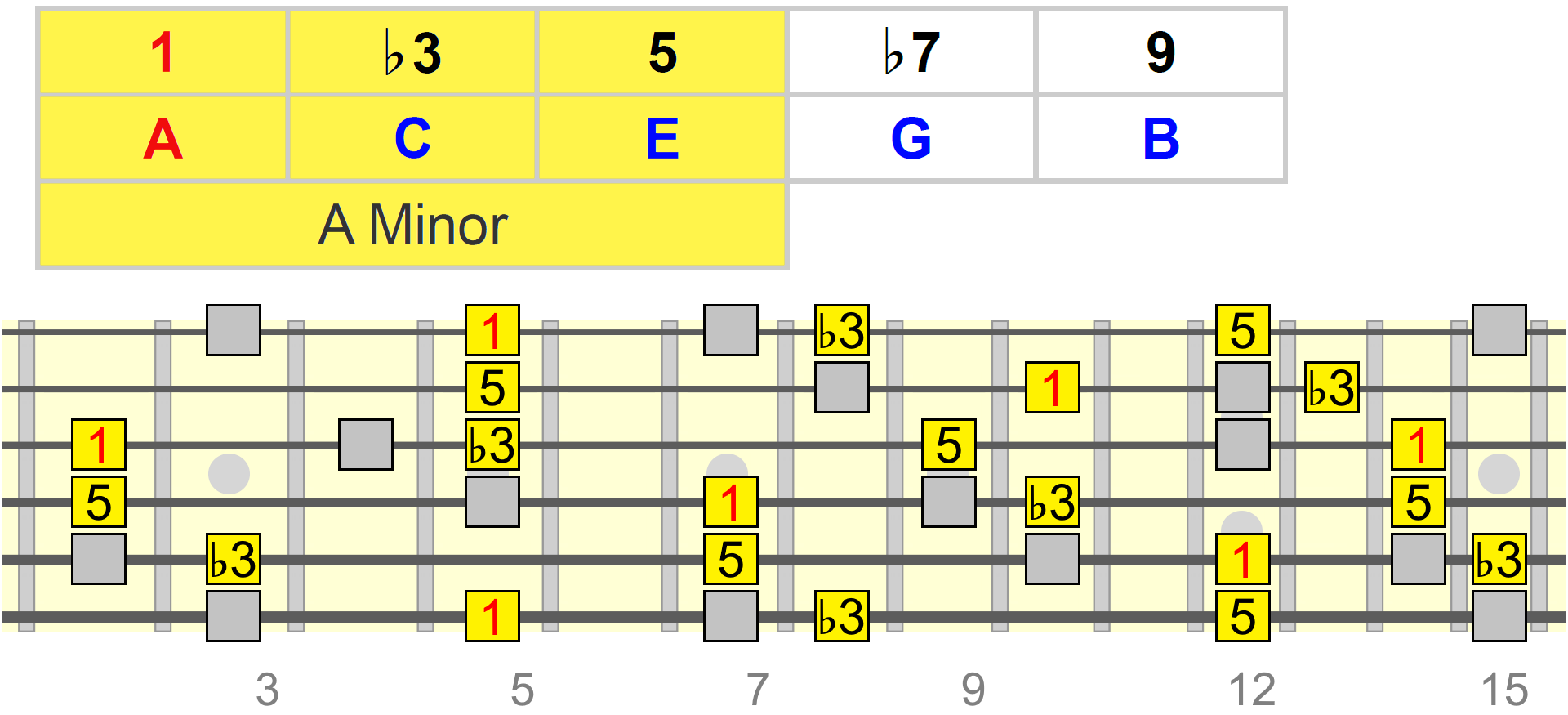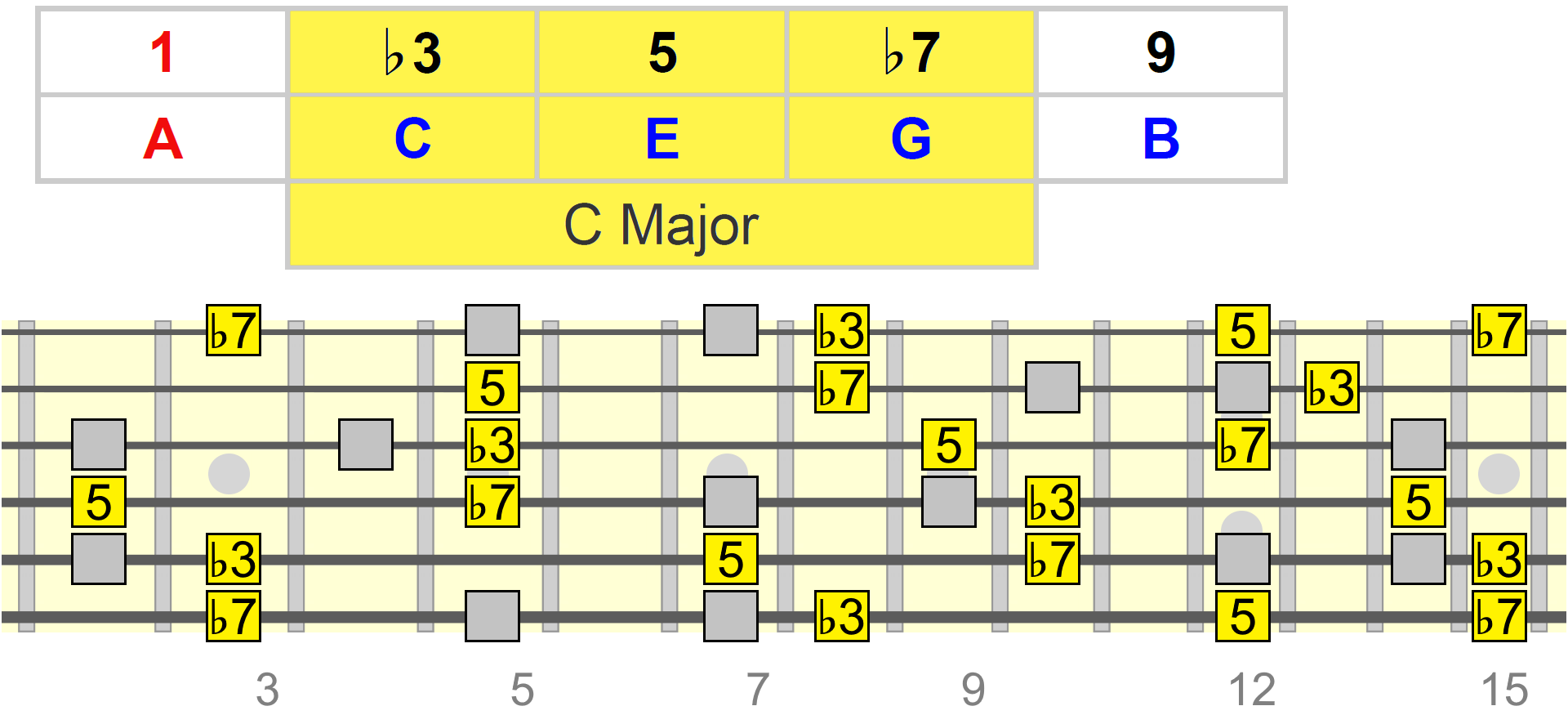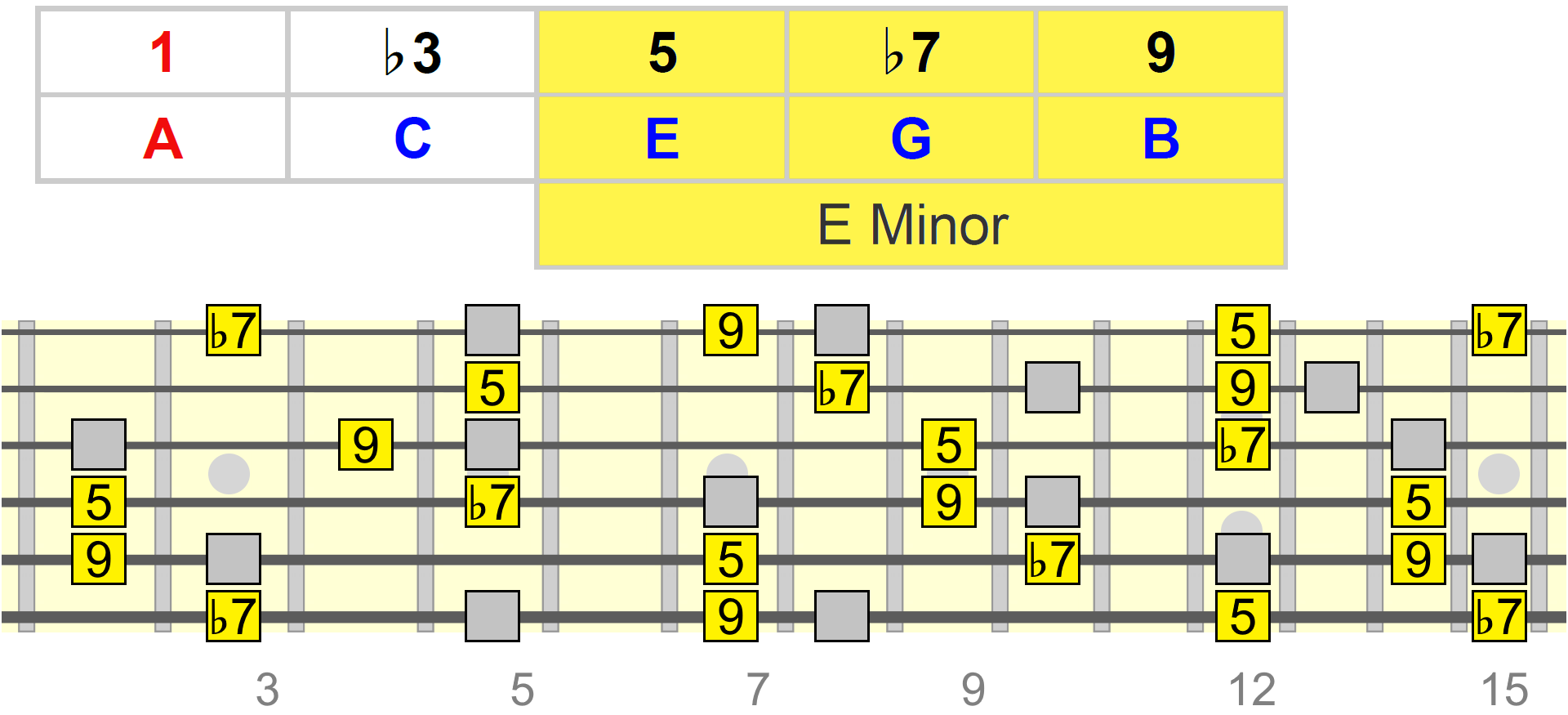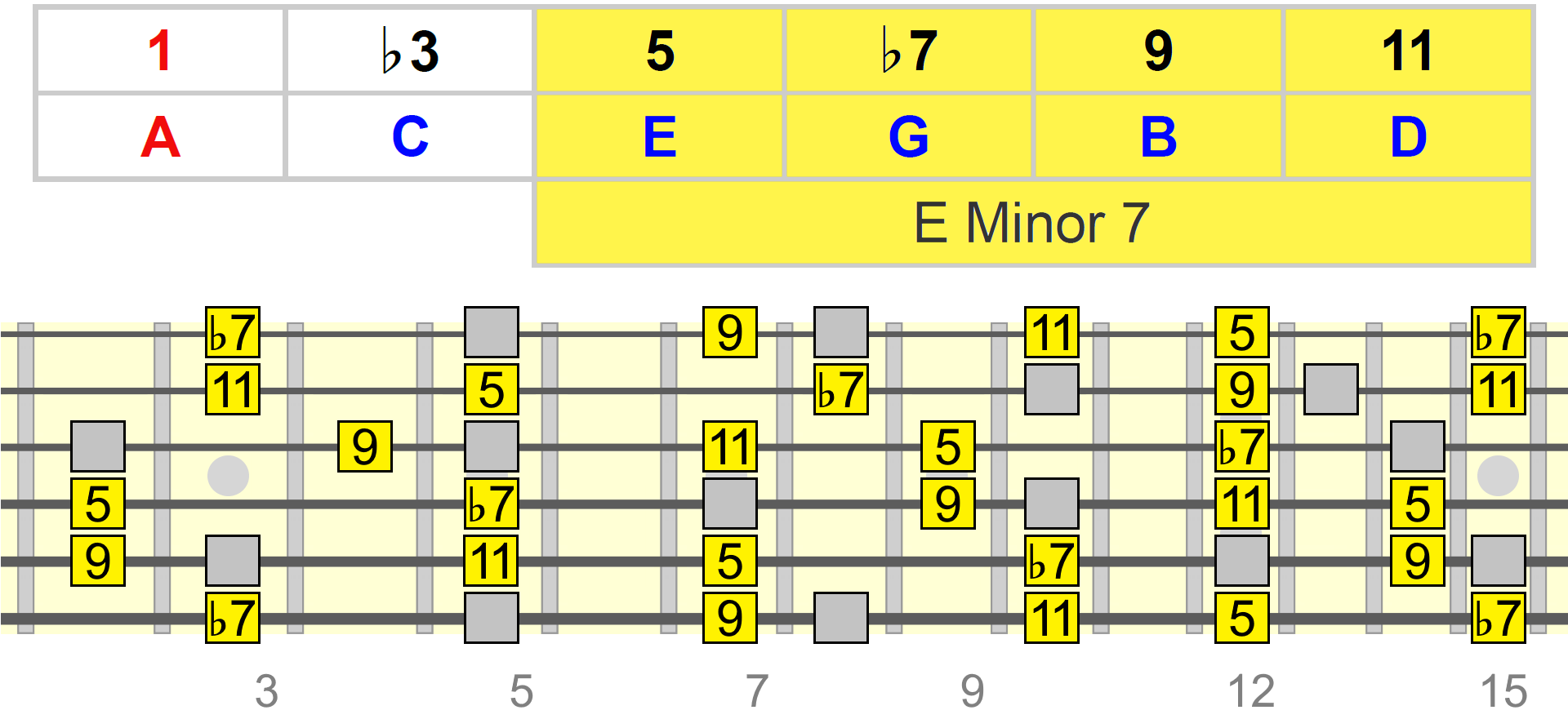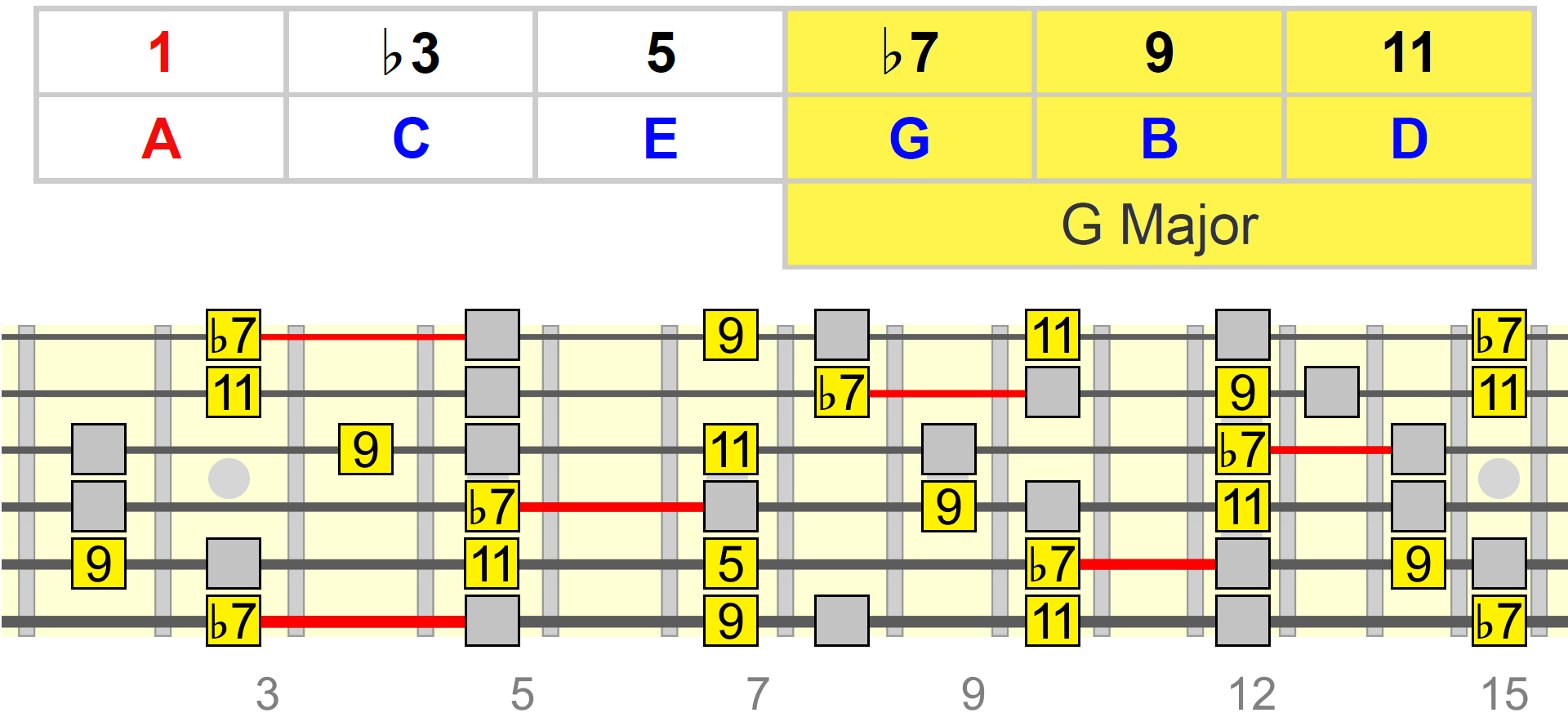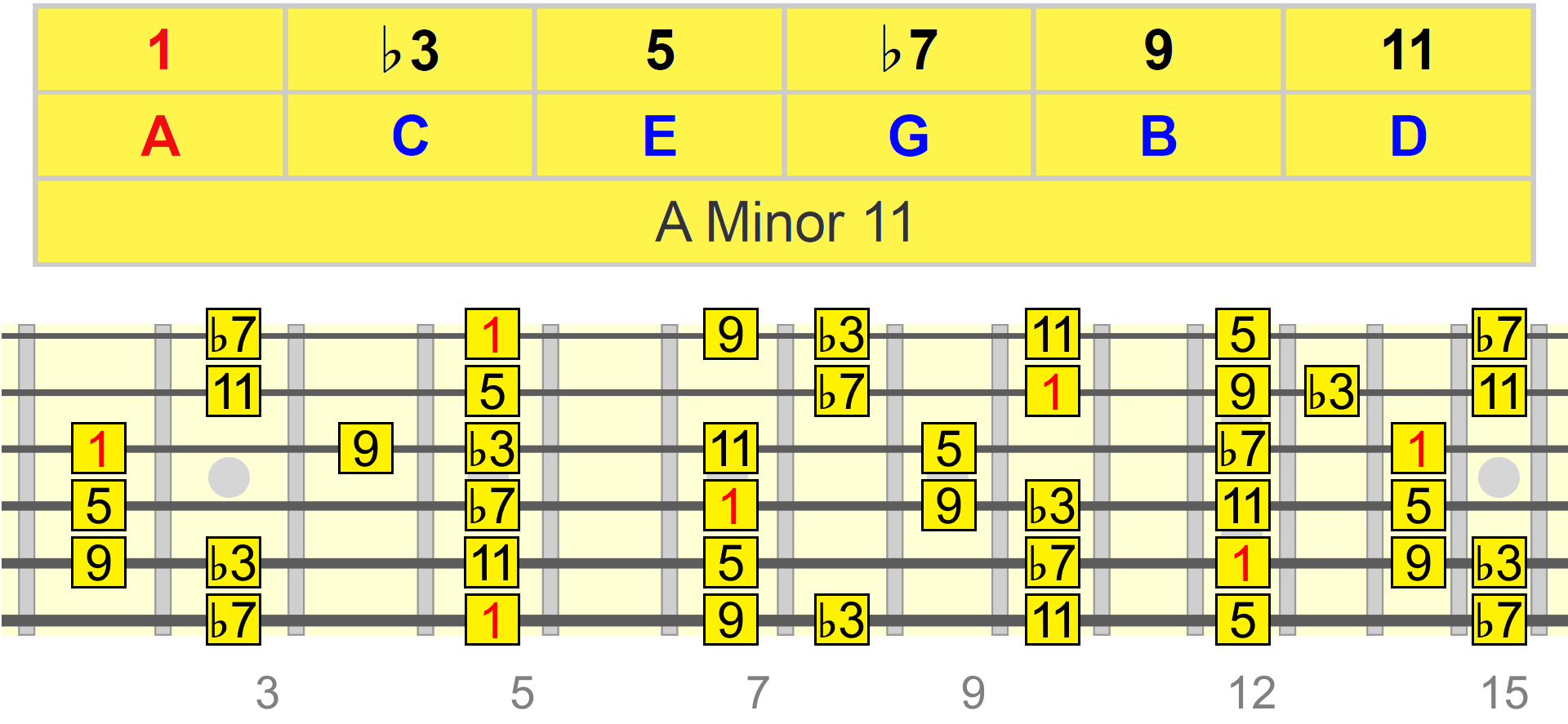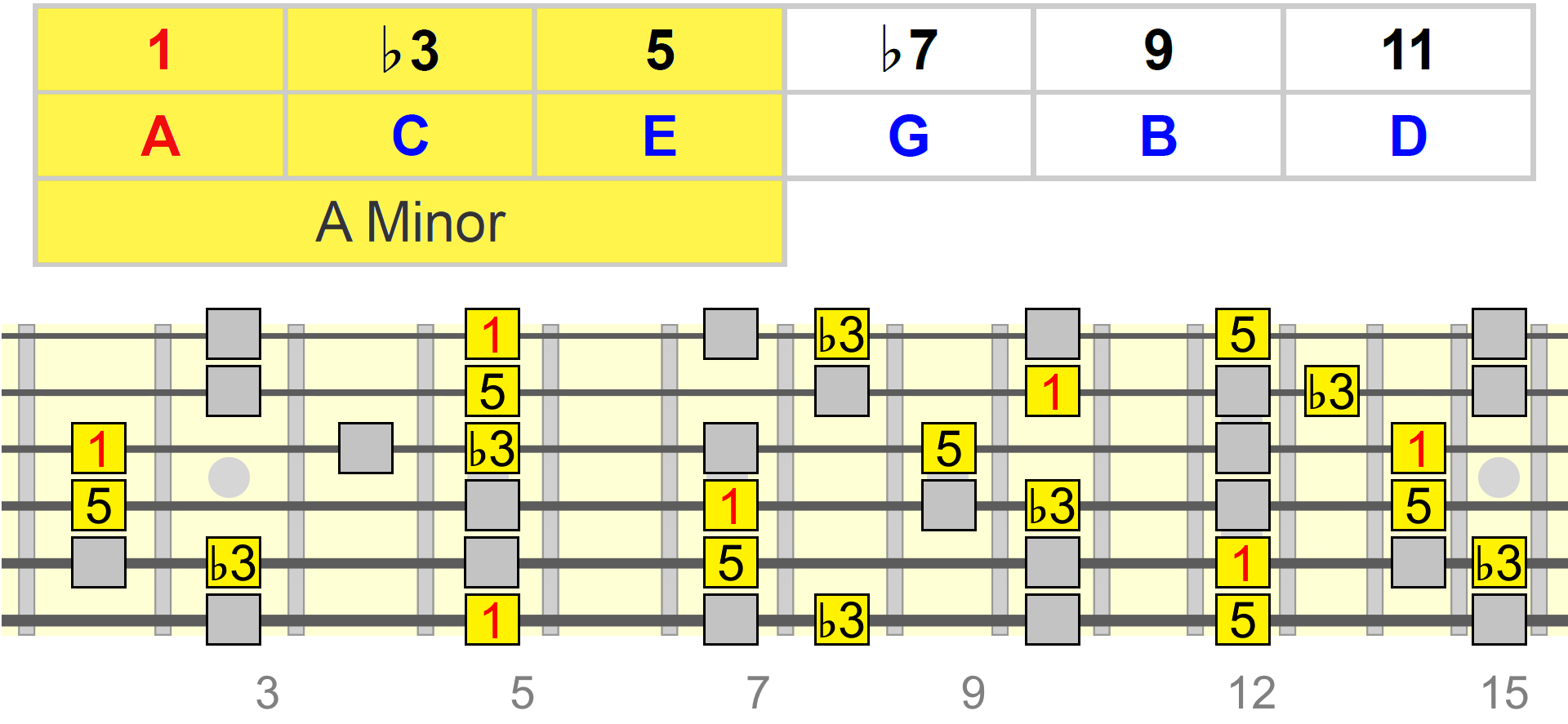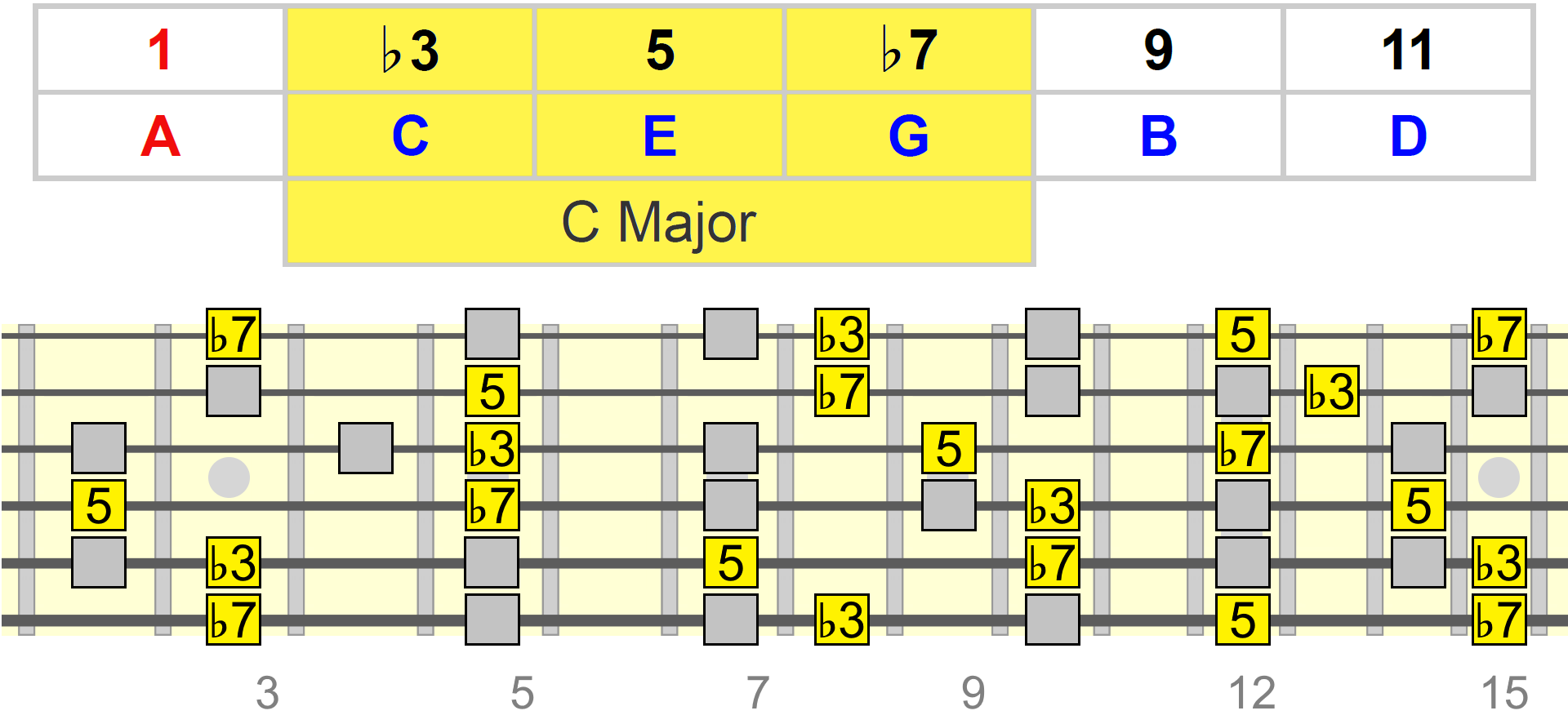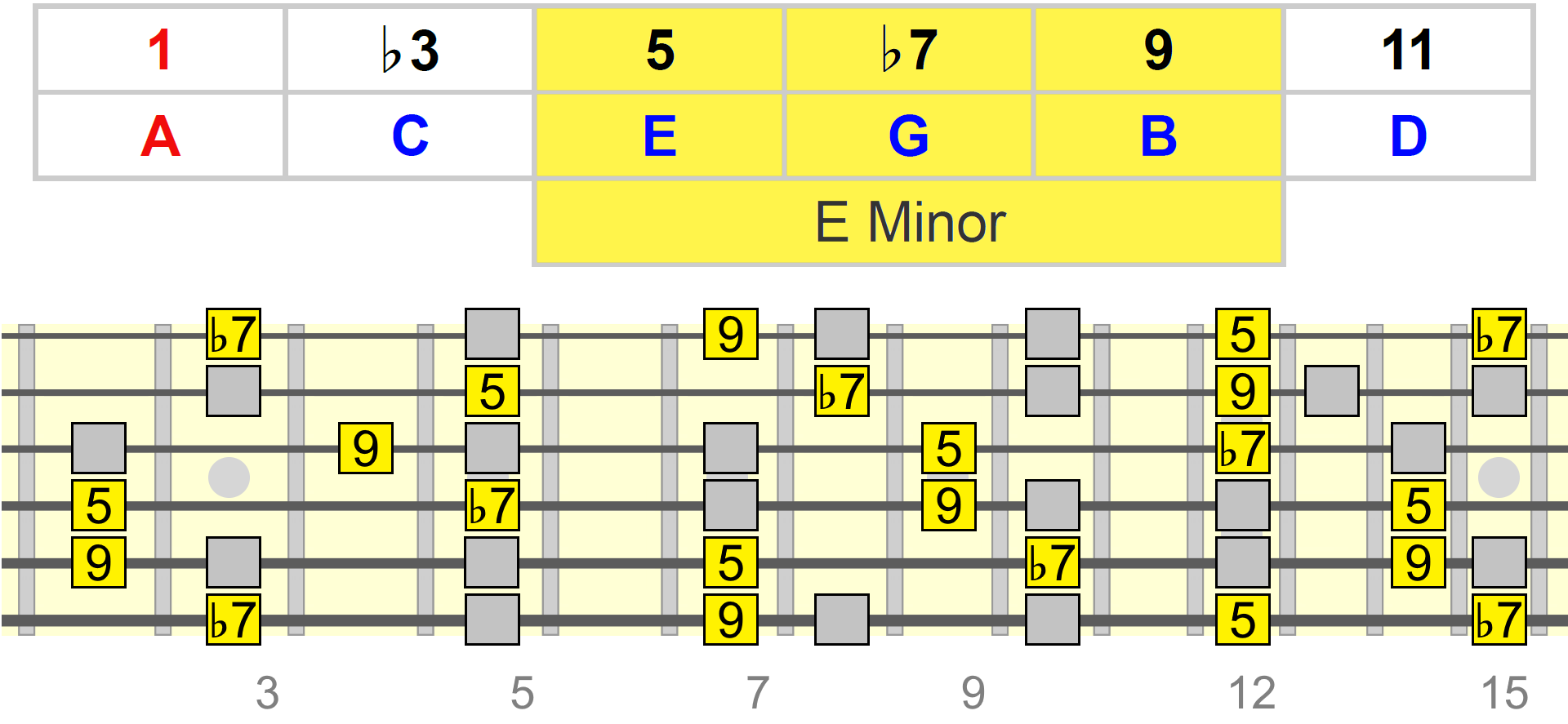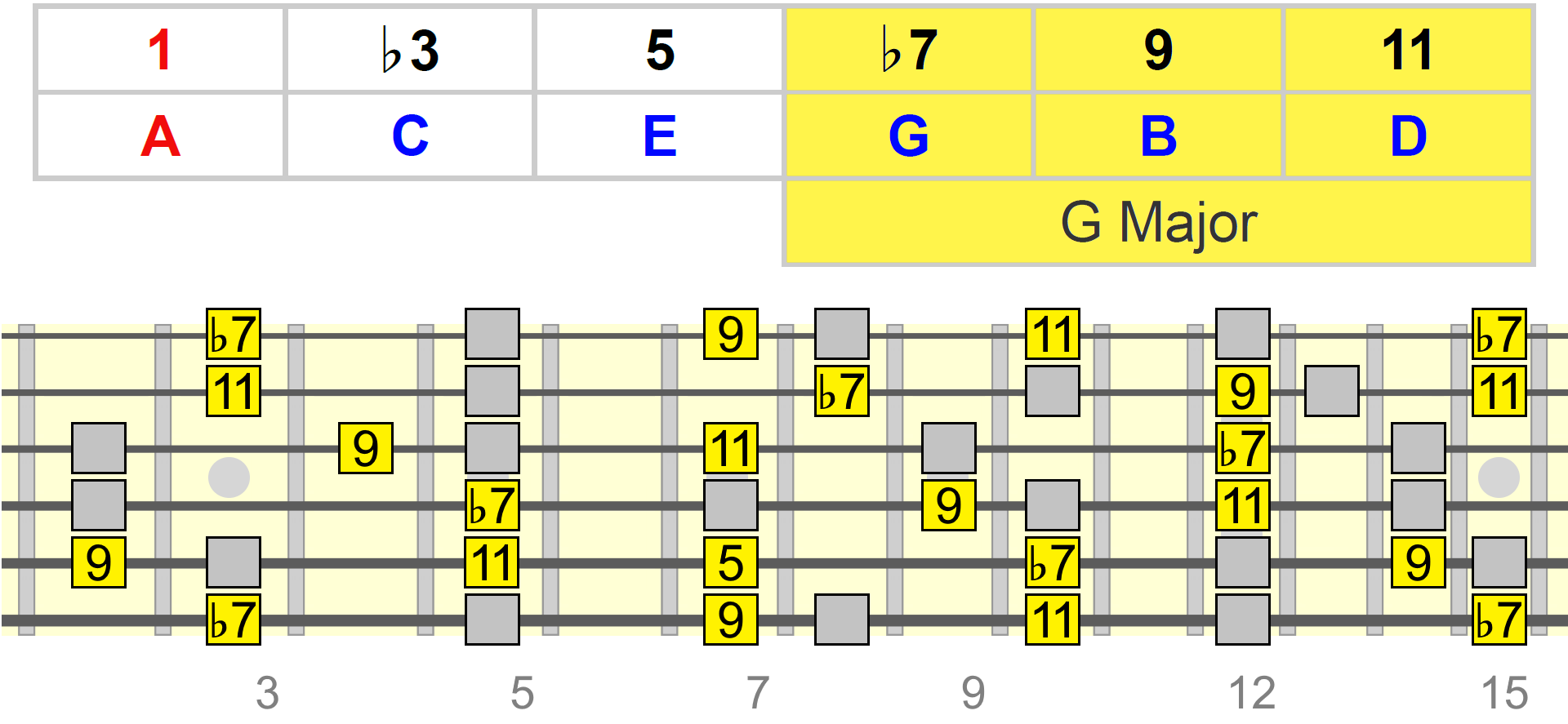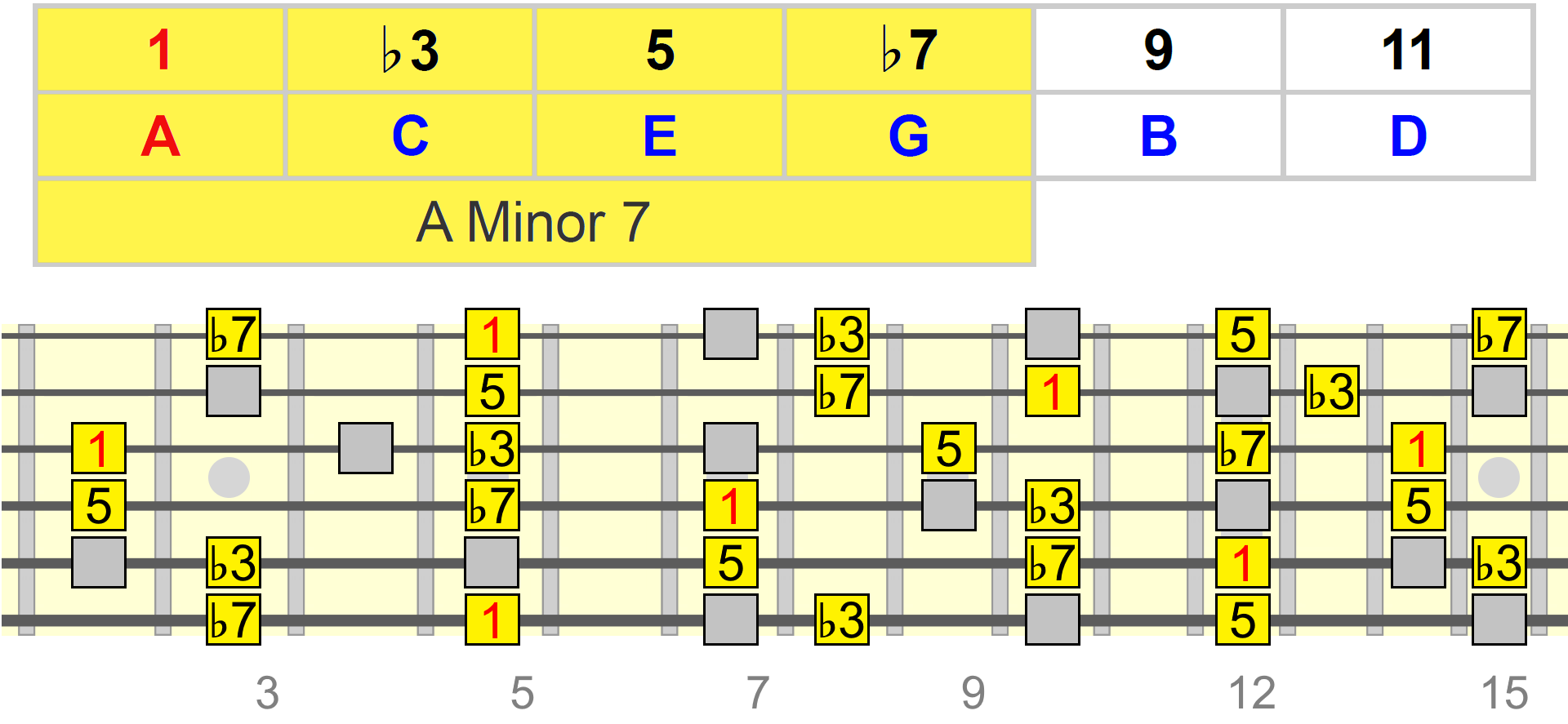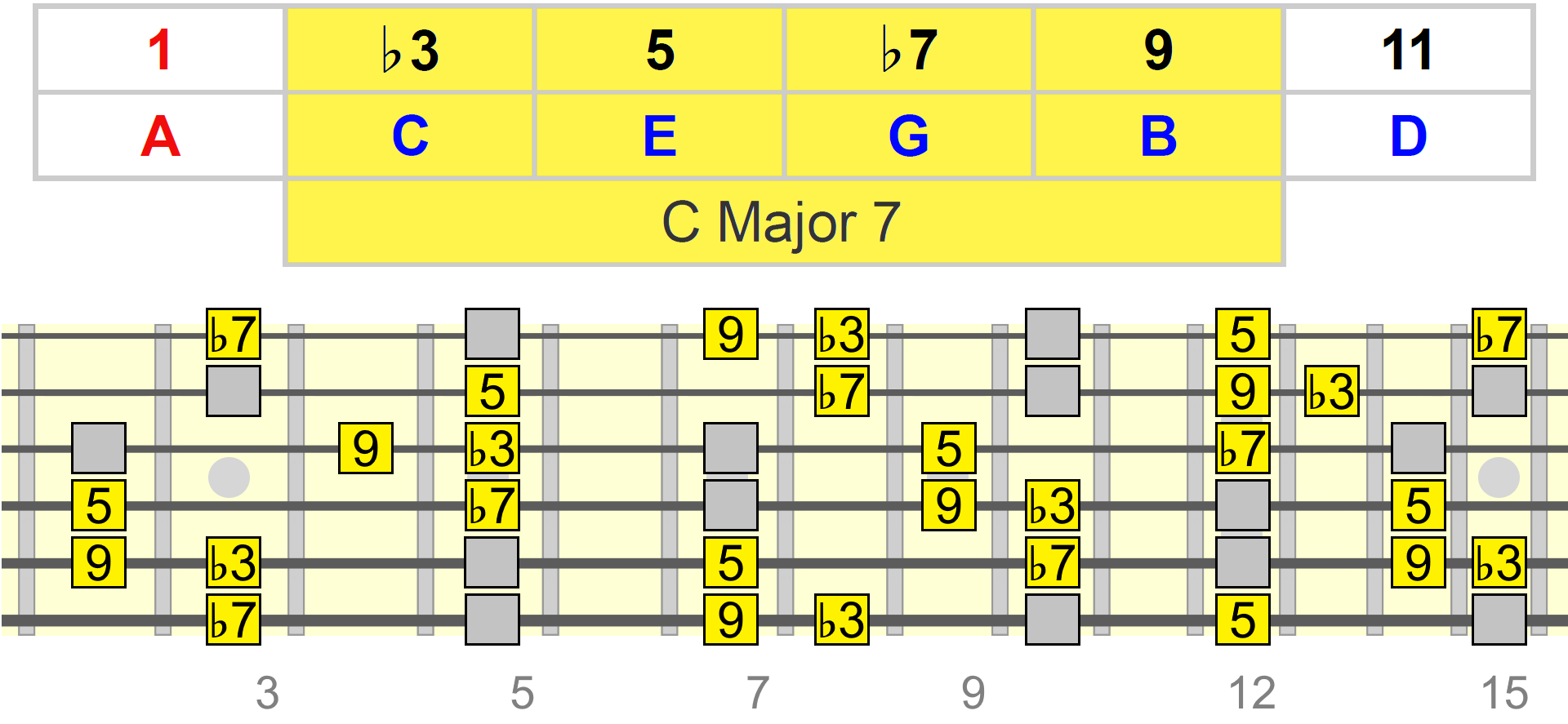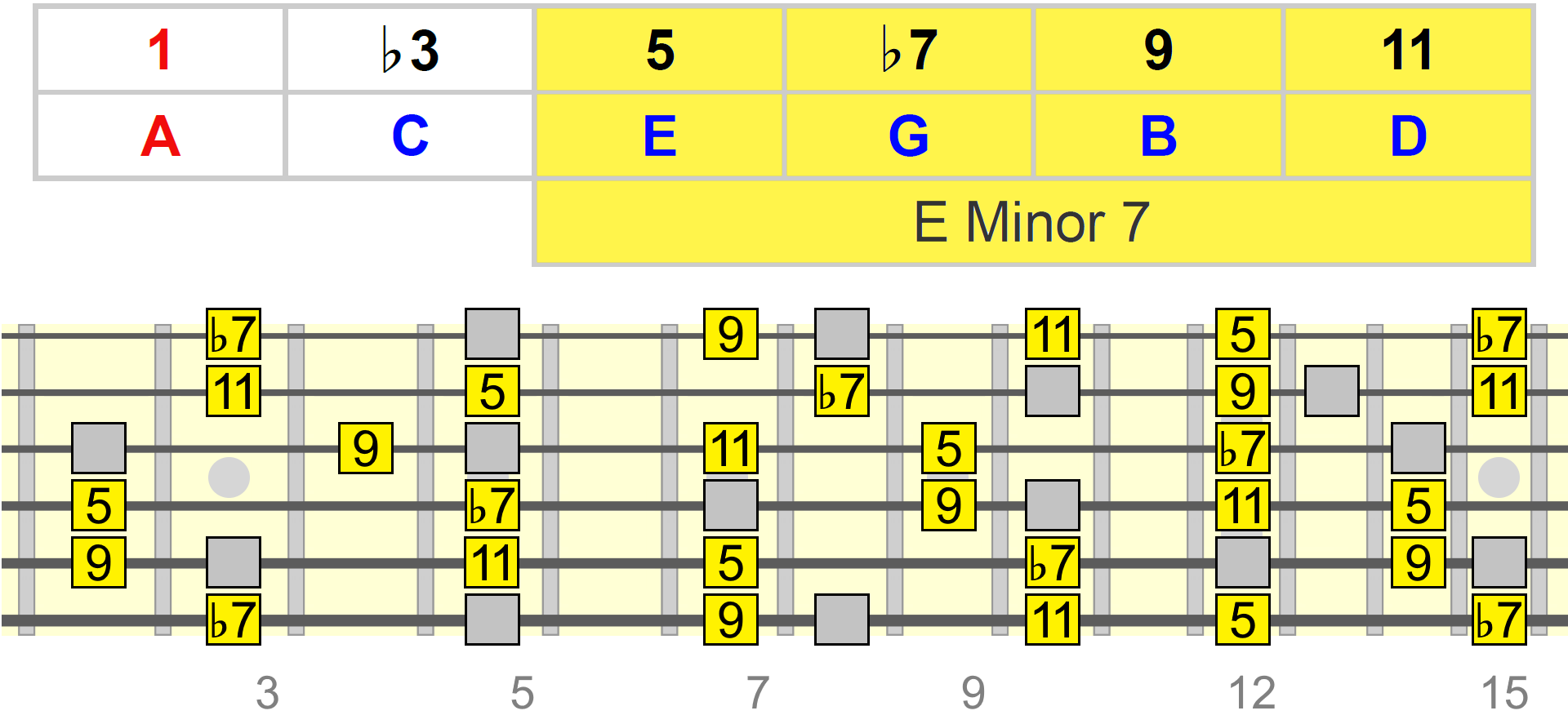Jump to...
Horizontal vs Vertical | Minor Triad | Minor 7th | Minor 9th | Minor 11th | Chord Changes + Jam Track
Horizontal Vs Vertical Melody
The melody or lead part of a piece of music consists of two main types of movement:
- Horizontal, which can be thought of as a predominantly linear sequence of tones, typically a half or whole step apart and derived from a scale.
- Vertical, which can be thought of as arpeggiating or outlining the backing chord, with a greater distance between each tone.
It's the combination of these two musical directions that can help us form dynamic, meaningful melodic phrases. On tab, you can usually identify the vertical sequences by how they form consecutive steps from string to string...
Minor Triad Arpeggios
All minor chords and scales consist primarily of the minor triad - root (1), minor 3rd (♭3) and 5th (5), here displayed in A minor (note the fret numbers below the diagram - we're starting at the 2nd fret here)...
Get to know this core minor arpeggio in different positions and on different roots (e.g. C, D, E, G etc.), ascending and descending. You might find it easiest to start by building them around familiar chord shapes/positions...
Using Arpeggios As Lead-Ins / Lead-Outs
Once you have these positions memorised, try leading the arpeggio, starting on any of its tones, into a regular scale phrase. For example, here the arpeggio precedes a Dorian lick...
This time I use an arpeggio to lead out of a phrase...
Lead-ins and lead-outs are a simple but effective way of using arpeggios and putting your scale phrases into context.
Minor 7th Arpeggios
Let's now add the flat/minor 7th (♭7) to our minor triad, positioned a whole step or two frets down from the root, giving us a minor 7th arpeggio (e.g. Am7)...

This will work over most occurrences of a minor chord. Some examples...
As you can see from those examples, we can skip tones/strings in the sequence to enhance the vertical effect...
Practice sequencing your arpeggios in different ways.
Triads Within Minor 7th
Now, what's interesting about the minor 7th arpeggio is that it contains two overlapping relative triads. In this case, A minor and C major. So the relative major arpeggio is rooted on the ♭3 of the minor chord we're playing over...
- A minor gives us the 1, ♭3 and 5
- C major gives us the ♭3, 5 and ♭7
Listen to how the C major arpeggio gets effectively reharmonised over A minor...
Over C Major
Over A Minor
So we have a choice between playing through the full minor 7th sequence, or breaking it up into its relative minor and major arpeggios.
Take this example where we start with an A minor 7 arpeggio, followed by C major, moving to a higher C major, and finally A minor 7, bending the 7th up a whole step to the root...
No matter how you break it down, the combination of these four tones (1, ♭3, 5, ♭7) gives us the minor 7th sound compatible with most minor chords.
Minor 9th Arpeggios
We're now going to extend this arpeggio further by adding the 9th (9), or the 2nd (2) in scale terms - a natural colour tone over minor chords.
It can be seen as positioned two frets up from the root, or one fret down from the ♭3. This gives us a minor 9th roadmap...
It's now starting to look like a scale, and technically it can be played in the manner of a pentatonic scale, since we now have five tones...
But we can give it a more vertical expression simply by sequencing it differently. For example, we could play the arpeggio in strict sequence from 1 to 9, outlining a minor 9th chord (e.g. Am9)...
Like before, we can also create skips in the sequence as follows...
Major 7th Arpeggio On The ♭3
Another way to see it is as a major 7th arpeggio on the relative major root, or the ♭3 of the minor chord we're playing over. In this case, that would give us Cmaj7.
This relative major 7th pattern becomes minor 9th over our minor chord, with the root omitted. So we're effectively reharmonising the major 7th pattern in a minor context...
Let's first break down our core patterns...
Over C Major
Over A Minor
Note: in the A minor example above, I resolved to the A root on the 5th fret.
Minor Triad On The 5
Again, we can see a related triad within this minor 9th pattern, this time built on the 5 of the minor chord we're playing over. So in relation to A minor, that's E minor in this case. The E minor arpeggio gives us the 5, ♭7 and 9 of our A minor chord...
Here I'm injecting an E minor arpeggio into an A minor scale phrase (yes, it's quite subtle!)...
These related triads are just another way of compartmentalising our vertical approach to lead playing...
Minor 11th Arpeggios
Finally, let's add the 11th to our minor roadmap. The 11th is the equivalent of the 4th in scale terms and is a natural colour tone of most minor chords.
It can be seen as a whole step up from the ♭3 or down from the 5. Our combined tones (1, ♭3, 5, ♭7, 9, 11) make up a minor 11th arpeggio...
Again, we could play this sequence of tones as a scale. You might see this minor 11th sequence as minor pentatonic with an added 2 (or 9)...
But as we're focusing on arpeggios, we can sequence the tones as a more vertical expression of the chord...
In the first example below, I resolve the arpeggio to a nearby ♭3. In the second, I resolve to the root...
Minor 7th Arpeggio on the 5
You could also see an Em7 arpeggio within the Am11 roadmap. Here we build a minor 7th arpeggio on the 5 of the minor chord we're playing over...
Major Triad On The ♭7
Like before, there's another related triad hiding within this minor 11th roadmap. G major in this case. This major arpeggio can be seen as built on the 7th, positioned two frets or a whole step down from the root of the minor chord we're playing over.
This G major arpeggio covers the ♭7, 9 and 11 of A minor. Another vertical compartmentalisation of the minor sound...
In the first example below, I resolve to a nearby root. And then to a ♭3...
At A Glance So Far...
So within this minor 11th roadmap we have several arpeggio options, rooted on different intervals of the chord, that serve to give our minor melody a more vertical expression and colour.
For triads...
- Minor triad on the 1
- Major triad on the ♭3
- Minor triad on the 5
- Major triad on the ♭7
Tip: Remember, where there's an arpeggio, there's a chord! So you can play any of these triads in their related positions as regular chords to add colour to the minor sound.
For 7th arpeggios...
- Minor 7th on the 1
- Major 7th on the ♭3
- Minor 7th on the 5
Whether you see the minor 11th roadmap as made up of related triads, 7th arpeggios, or even just sections of the full minor 11th arpeggio, we can incorporate any of these sequences freely into our scale phrases.
This table summarises which arpeggios you can build on each interval of the backing chord...
Minor 11th Through Chord Changes
Let's try applying these arpeggios to a simple two chord sequence.
Here I'm changing between Am and Dm, or the i and iv chords in the natural A minor key.
So we're first going to get comfortable with our Am and Dm arpeggios, based around their respective minor 11th roadmaps. These arpeggios will form the basis of our melody...
Let's start really simple with the base triads for each chord, starting with Am. The grey chord names below each tab indicate the related arpeggios being used over each chord...
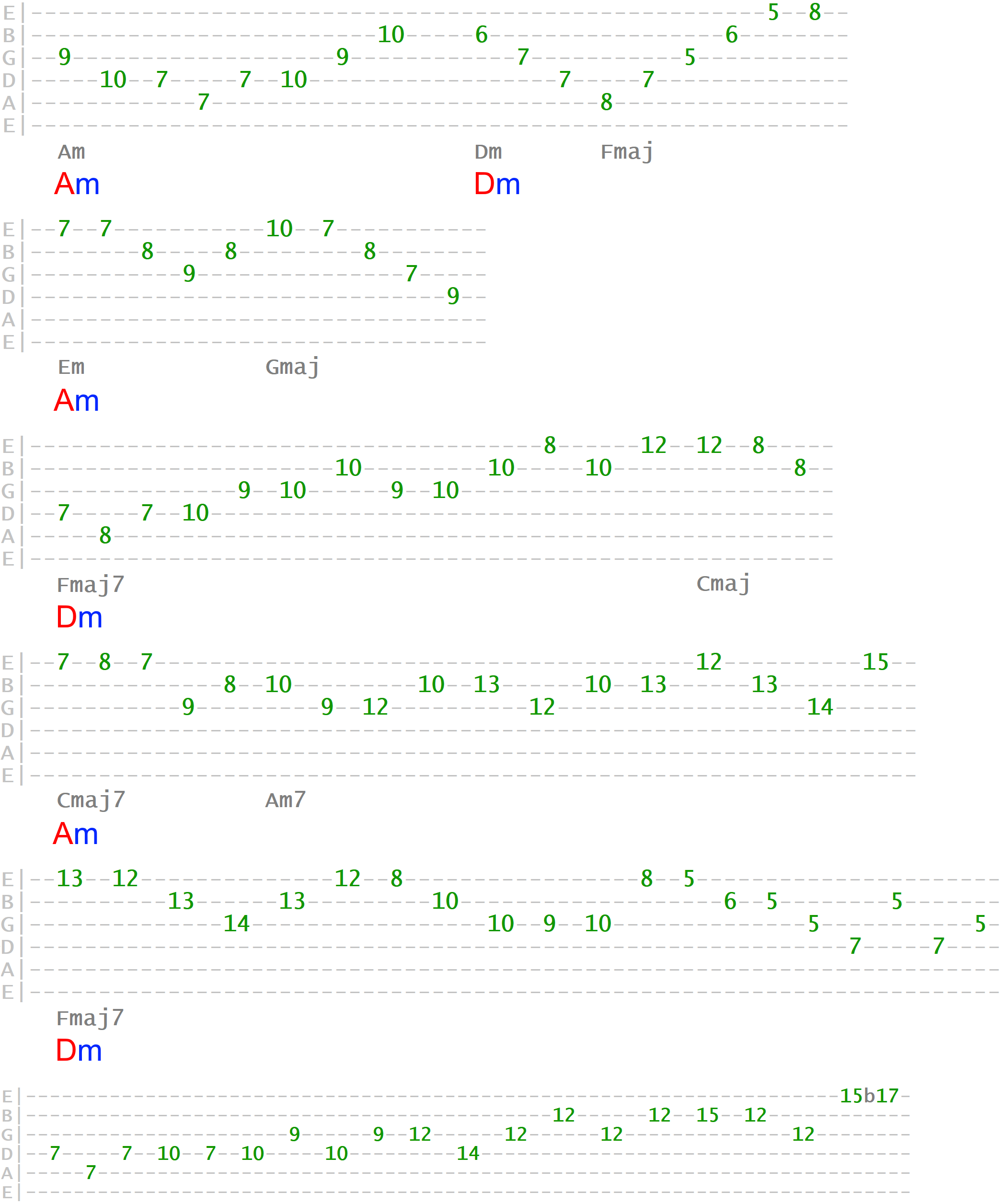
Using One Roadmap In The Same Key
Not only do these arpeggios work over most instances of a minor chord, they also work well over other chords in both relative minor and major keys. The same minor 11th tones get reharmonised to the related chord we play over.
Below I'm using same Am11 sequence over four chords in the same A minor key - Am, Cmaj, Dm and Fmaj...
Over the 3 (III) chord, Cmaj in this case, and the relative major tonic of A minor, the Am11 arpeggio gives us a major 13th (e.g. Cmaj13) colour...
Over the 4 (iv) chord, or Dm in this key, the Am11 arpeggio gives us a minor 13th (e.g. Dm13) colour...
We'll look more specifically at colouring major and also dominant 7th chords with their own arpeggios in another part.
In Summary...
We can approach most minor chords vertically using a minor 11th roadmap, breaking it up into several related triads and 7ths.
But the general concept here is that, by combining these vertical movements with more linear scale movements (even just pentatonic scales), you'll find it much easier to write, improvise and train your ear to musical phrases.
It's not just about minor chords either - I hope you come away from this lesson with a new conceptual awareness of vertical phrasing within your licks. Given time, maybe they'll become a natural part of your playing and you'll see your lead playing as an expression of chord colours as well as smoother, horizontal passages.
Thank you for your time with all this!
